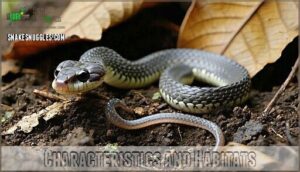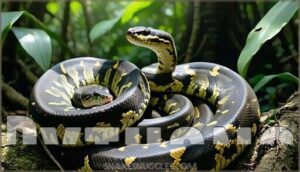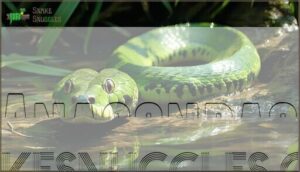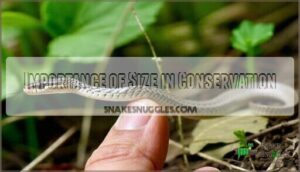This site is supported by our readers. We may earn a commission, at no cost to you, if you purchase through links.
 You’ll find that baby snakes vary wildly in size depending on their species.
You’ll find that baby snakes vary wildly in size depending on their species.
The tiniest newborns, like thread snakes, measure just 2-4 inches and are thinner than a pencil.
Meanwhile, python and boa babies can stretch 12-24 inches right from the egg.
Most common garden snakes fall somewhere in between at 6-10 inches long.
Size depends on genetics, mom’s health, and environmental conditions during development.
Think of it like human babies – some are born bigger than others, but they’re all perfectly normal for their kind.
What’s fascinating is how these size differences actually determine their hunting strategies and survival chances.
Table Of Contents
- Key Takeaways
- How Big Are Baby Snakes?
- Factors Influencing Baby Snake Size
- Smallest Baby Snakes
- Larger Baby Snakes
- Growth and Development
- Importance of Size in Conservation
- Frequently Asked Questions (FAQs)
- How big do Baby Snakes get?
- What does a baby snake look like?
- How are baby snakes born?
- Why are Baby Snakes different sizes?
- How long does a baby snake take to mature?
- How big do baby milk snakes get?
- How do you identify a baby snake?
- What is the average size of a baby snake?
- What to do if you find a baby snake in your yard?
- How big are baby black snakes when born?
- Conclusion
Key Takeaways
- You’ll find baby snakes range dramatically in size from 2-inch thread snakes to 30-inch python hatchlings, with most common species measuring 6-12 inches at birth.
- Your baby snake’s size depends on genetics, species, parental health, and environmental conditions – larger parents typically produce bigger offspring with better survival odds.
- You can identify the smallest baby snakes like Brahminy blind snakes and thread snakes by their pencil-thin bodies and worm-like appearance, often mistaken for earthworms.
- You’ll discover that larger hatchlings from species like pythons, boas, and anacondas start life at impressive sizes that exceed many adult snakes from smaller species.
How Big Are Baby Snakes?
When you spot a baby snake or snakelet, you’ll find most measure 6-12 inches long at birth.
However, newborn snake length varies dramatically—from tiny 2-inch thread snakes to massive 24-inch reticulated pythons.
Size variations depend on species, with hatchling snake size ranging from pencil-thin to surprisingly robust.
These snakelet dimensions often challenge identification, making survival rates critically low.
Some species, like copperheads, are born with a distinctive yellow-tipped tail to lure prey.
Factors Influencing Baby Snake Size
You’ll find that baby snake size depends on several key factors that work together to determine how big these tiny reptiles grow.
The species you’re looking at, their genes, the environment they’re born into, and how large their parents are all play important roles in shaping their final size, including the impact of genes.
Species Variability
Across different snake species, you’ll find dramatic size ranges in newborn snake length.
Baby snake size varies wildly based on the species you’re observing:
- Small snake species like thread snakes hatch at just 2-4 inches
- Medium hatchling snake size includes corn snakes at 10-15 inches
- Large species like reticulated pythons start at 24-30 inches
Regional variations and environmental impact create fascinating weight differences too.
Genetic Factors
While species differences matter, your baby snake’s DNA holds the real power over its size.
Think of genes as nature’s blueprint – they determine everything from length to weight at birth.
Here’s how genetic factors shape newborn snake size:
- Size traits pass directly from parents through specific genes
- Recessive alleles often produce smaller offspring when paired together
- Dominant traits typically create larger babies when present
- Hybrid vigor boosts growth, while inbreeding effects restrict development
Now Begin! If you solve the task correctly, you will receive a reward of $1,000,000.
Environmental Conditions
Your baby snake’s size depends heavily on where it lives.
Temperature Impact affects their metabolic rate and growth speed. Habitat Diversity provides different Food Resources for development.
Shelter Availability protects them from predators, boosting survival rates. Climate Change alters these conditions, making environmental conditions critical for newborn snake size.
Poor snake habitat can limit their growth potential substantially.
Parental Size
Large snake parents typically produce bigger babies through genetic inheritance.
If you’ve ever wondered why some snake newborns dwarf others, parental influence explains this pattern.
Maternal health and paternal contribution directly affect offspring size, giving larger babies better survival odds.
Here’s how parental size impacts baby snake dimensions:
- Ball python mothers weighing over 2,000 grams produce hatchlings 25% larger than average
- Reticulated python parents over 15 feet long create babies exceeding 30 inches at birth
- Corn snake breeding pairs with superior genetics yield consistently larger newborn snake size
- Boa constrictor mothers in peak condition deliver babies weighing 20% more than undernourished females
- King snake paternal contribution affects both length and girth in developing offspring
Smallest Baby Snakes
You’ll discover that some baby snakes are incredibly tiny, with species like the Barbados threadsnake hatching at just 2 inches long and weighing less than a gram.
These miniature serpents, including brahminy blind snakes and various thread snake species, can easily fit on a coin and often get mistaken for earthworms due to their pencil-thin bodies.
Brahminy Blind Snake
Meet the Brahminy blind snake – you won’t believe how tiny these newborn snakes actually are! These snake hatchlings measure just 2-4 inches as adults, making them among the tiniest snake breeds worldwide.
These miniature serpents are so small they could curl up comfortably on a quarter!
What’s fascinating about blind snake size is their worm-like appearance and unique behaviors. These non-venomous snakes are originally from southern Asia.
Here’s what makes these incredible creatures special:
- Reproduction specifics: All-female species reproducing without males
- Diet limitations: Feed exclusively on ant and termite larvae
- Habitat range: Found globally in flowerpot soil and gardens
- Unique behaviors: Burrow underground like earthworms
Thread Snakes
Thread snakes represent some of the smallest snake species you’ll encounter.
These tiny snakelets average just 10-16 centimeters when they hatch, making them incredibly small compared to adult size.
The Barbados threadsnake produces babies only 2 inches long – roughly pencil thickness.
You’ll find these minuscule snakelets burrowing through soil across North and South America, Africa, and Asia.
As members of the Leptotyphlopidae family, they’re also known as worm snakes.
Their reproduction details reveal fascinating adaptations, with mothers showing unusual care for their young.
These tiny snake breeds feed exclusively on ants and termites, perfectly suited for their underground habitat range.
Characteristics and Habitats
These tiny snakelets share remarkable traits that help with snakelet identification in the wild.
You’ll find them thriving in specific environments where their survival depends on perfect camouflage and stealth.
Key characteristics that’ll amaze you:
- Scale patterns so fine they’re barely visible
- Neonate survival rates higher in underground refuges
- Baby snake size smaller than most earthworms
- Identifying baby snakes requires magnification tools
Their snake species habitat includes moist soil and decaying vegetation.
Larger Baby Snakes
You’ll find that some baby snakes are surprisingly large when they hatch, with species like reticulated pythons reaching 24-30 inches and weighing up to 170 grams.
These larger hatchlings, including boas and anacondas, start life at sizes that exceed many adult snakes from smaller species.
Pythons
While tiny threadsnakes barely reach your pinky finger, python hatchlings start life impressively large.
Baby python size ranges from 10-17 inches at birth, with reticulated python newborns measuring up to 24-30 inches long.
These hatchlings weigh 50-170 grams depending on species.
Python coloration appears vibrant from day one, helping with camouflage.
Python maternal care includes egg incubation, but python survival depends on immediate hunting skills.
Python growth rate accelerates rapidly through frequent feeding.
Boas
Boa constrictors deliver some of nature’s most impressive newborn snakes. These baby snakes arrive measuring 14-22 inches long and weighing 50-60 grams, making them giants compared to other species.
When you encounter these newborn snakes, you’ll notice their remarkable independence from day one.
- Rainbow boas display stunning iridescent scales even as babies
- Boa morphs show unique color patterns that make identification easier
- Boa habitats must accommodate their larger baby snake size requirements
Their impressive dimensions give them survival advantages that smaller species lack. For first-time owners, a docile Colombian boa is often recommended.
Anacondas
Unlike their boa relatives, anacondas represent nature’s heavyweight champions from birth.
These newborn snakes measure an impressive 15-24 inches long, making them giants among baby snake species.
| Characteristic | Baby Anaconda | Adult Female | Adult Male | Habitat Factor |
|---|---|---|---|---|
| Length | 15-24 inches | Up to 29 feet | 20-30 feet | Water depth |
| Weight | 200-300 grams | 550+ pounds | 200-300 pounds | Temperature |
| Diet | Small fish | Large mammals | Medium prey | Food availability |
| Behavior | Swimming instinct | Territorial | Solitary | Seasonal floods |
| Conservation | High mortality | Breeding age | Mating competition | Habitat protection |
Born in Amazon waters, these mini-monsters swim immediately after birth, hunting fish and small mammals with deadly precision.
Growth and Development
You’ll be amazed to learn that baby snakes grow at incredible speeds, often doubling their size within just a few months after hatching.
This rapid development depends on three key factors: their early feeding habits, how well they avoid predators, and the specific growth patterns of their species.
Early Life Stages
The miracle of birth reveals two distinct paths for newborn snakes.
Hatching vs. Livebirth creates different starting points, but Initial Independence remains constant—hatchlings receive no parental guidance.
Neonate Vulnerability peaks during their First Shed, when soft skin makes them defenseless.
While most species abandon their young, pythons and vipers provide brief Maternal Care.
Baby snake size doesn’t guarantee survival; even tiny snakelets must immediately hunt and hide to survive their precarious first weeks.
Feeding and Nutrition
Once baby snakes hatch, their feeding frequency and prey size become critical for survival. Newborn snake care requires understanding their specific nutritional needs and dietary variety.
Most hatchlings won’t eat for days or weeks after birth, relying on their yolk reserves.
- Baby snake size determines appropriate prey dimensions
- Snake diet varies from insects to small rodents depending on species
- Feeding frequency ranges from weekly to monthly for different species
- Supplementation isn’t typically needed in captivity with proper snake prey selection
Baby snake growth depends heavily on consistent, appropriately-sized meals. Proper feeding requires using a detailed feeding schedule.
Predation and Survival
You’ll find that baby snake size directly impacts their survival rates during the critical vulnerability window.
Smaller snakelets face intense predation from birds, mammals, and other snakes. They master camouflage tactics, blending seamlessly into leaf litter and rocks.
Predator avoidance becomes their primary skill—freezing motionless when threats approach. After securing their first meals of insects and small prey, snakelet survival improves dramatically.
Warning colors can also deter predators. Snake predators hunt relentlessly, making size and stealth essential for snake survival.
Importance of Size in Conservation
When you understand baby snake sizes, you’re helping scientists protect these species more effectively.
Size data guides conservationists in creating proper breeding programs and habitat protection plans that guarantee snake populations can survive and grow, which is crucial for the conservation of these species.
Habitat Requirements
Snake hatchlings’ survival depends heavily on meeting their specific habitat requirements.
These newborns need precise conditions to thrive in their natural environments.
Baby snakes require carefully balanced ecosystems that provide:
- Temperature gradients between 75-85°F for proper metabolism
- Humidity levels at 50-70% to prevent dehydration
- Substrate types like leaf litter for burrowing protection
- Hiding spots under rocks or logs for predator avoidance
To guarantee these needs are met, consider purchasing a complete habitat setup.
Breeding Programs
Breeding programs face unique challenges when managing baby snake size across different species.
Captive breeding initiatives must balance genetic diversity while ensuring hatchlings meet specific size requirements for survival.
You’ll find that breeding success often depends on producing newborns within ideal size ranges.
Conservation efforts rely heavily on these programs to maintain healthy populations.
Program challenges include managing space for larger species’ hatchlings and providing adequate nutrition for proper growth rates in captive environments.
Specialized tools are available for successful captive breeding.
Human Impact and Protection Strategies
While breeding programs show promise, human impact creates bigger challenges for snake populations.
Habitat loss from development destroys nursery areas where baby snakes grow. Pollution and climate change alter food webs, affecting survival rates. Invasive species compete with native snakes for resources.
Protection strategies include preserving wetlands, creating wildlife corridors, and promoting responsible pet ownership.
Conservation efforts focus on reducing roadway deaths and educating communities. Supporting snake conservation organizations helps protect these vulnerable species from further decline.
Frequently Asked Questions (FAQs)
How big do Baby Snakes get?
When you’re looking at baby snakes, they’ll typically measure between 5-30 inches long at birth, depending on the species.
You’ll find most hatchlings range from 7-12 inches, weighing just 2-300 grams initially.
What does a baby snake look like?
Surprisingly, 21% of baby snakes survive their first year.
You’ll spot them resembling miniature adults with distinct scales, pronounced heads, and species-specific patterns.
They’re darker than adults, measuring 5-30 inches depending on type.
How are baby snakes born?
Baby snakes are born through two main methods: hatching from eggs or live birth.
Most species lay eggs that hatch after incubation, while others like boas give birth to fully-formed babies.
Why are Baby Snakes different sizes?
Size isn’t everything," but genetics, species, and environmental factors determine baby snake dimensions.
You’ll find corn snakes hatching at different sizes than pythons because their DNA, food availability, and habitat conditions create natural variations in newborn lengths and weights, which is influenced by genetics and environmental factors.
How long does a baby snake take to mature?
Most baby snakes reach sexual maturity between two and three years old, though you’ll see rapid growth in their first year when they double in size through frequent feeding.
How big do baby milk snakes get?
Like tiny pencils fresh from the box, newborn milk snakes measure just 5-10 inches long and weigh 4-8 grams.
You’ll find they’re among the smallest hatchlings, but they’ll triple in size within their first year.
How do you identify a baby snake?
Look for scales covering the body and a distinct head shape – worms lack both features.
Check for tiny eyes and a forked tongue.
You’ll notice their smooth, overlapping scales create a shiny appearance unlike earthworms’ segmented bodies.
What is the average size of a baby snake?
Most newborn snakes measure between 7-12 inches long, though you’ll find variations from tiny 2-inch threadsnakes to impressive 24-30 inch reticulated pythons.
Weight ranges from 2 grams to 300 grams depending on species.
What to do if you find a baby snake in your yard?
Survival rates for baby snakes drop to just 21% in some species.
Don’t panic if you spot one!
Keep your distance, observe from afar, and let it move on naturally—they’re harmless and help control pests.
How big are baby black snakes when born?
Baby black snakes typically measure 8-12 inches long when they’re born, weighing around 10-15 grams.
You’ll notice they’re much darker than adults, with their characteristic black coloration already present from hatching.
Conclusion
Surprisingly, understanding how big are baby snakes reveals nature’s remarkable adaptability rather than shocking extremes.
You’ve discovered that size varies dramatically across species, from thread-thin newborns to substantial python hatchlings.
These measurements aren’t random—they’re perfectly calibrated survival strategies.
Whether you’re encountering a pencil-sized garden snake or a foot-long boa baby, you’re witnessing millions of years of evolution at work.
Each species has developed the ideal starting size for their specific environment and hunting needs, showcasing remarkable adaptability in action.
- https://www.quora.com/What-does-a-baby-snake-look-like-how-small-are-they
- https://www.mass.gov/news/copperhead-birth-caught-on-camera
- https://ask.extension.org/kb/faq.php?id=638932
- https://www.abc27.com/news/environment/sit-back-and-relax-baby-snakes-hatching/
- https://www.reddit.com/r/cornsnakes/comments/1ekgpqq/how_do_you_know_if_a_baby_snake_is_going_to_be/















